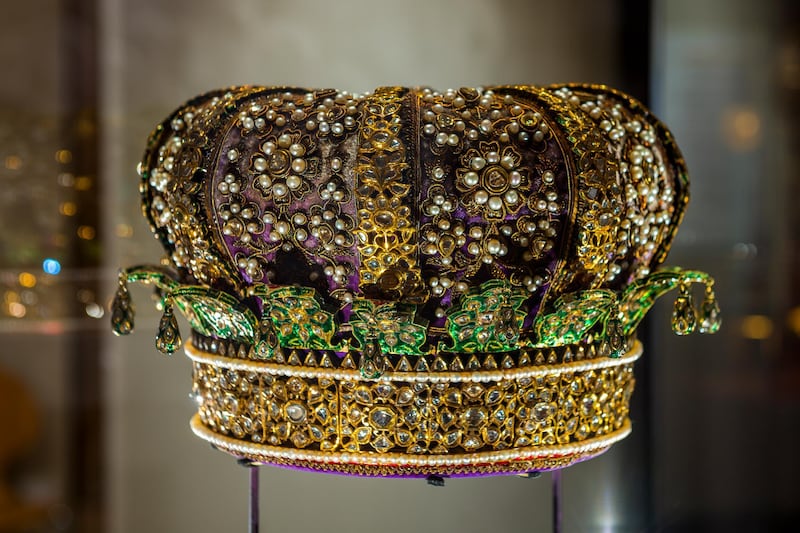In October 1875, Queen Victoria's eldest son Albert Edward, Prince of Wales (later King Edward VII), boarded HMS Serapis and made a passage to India. As with earlier major royal tours he had undertaken – one to Canada and the United States, another to Egypt and the Middle East – this trip would strengthen diplomatic links but also enable the heir apparent to learn more about a country he would one day rule.
In the course of his four-month trip, the prince travelled by boat, rail, carriage and elephant to all corners of the Indian subcontinent. He visited more than 21 towns and cities in modern-day India, Pakistan, Nepal and Sri Lanka and was guest at more than 90 royal courts. In accordance with Indian protocol, each regional ruler presented him with elaborate gifts which ranged from jewellery to weaponry, ceremonial objects to courtly nick-nacks. All items received – more than 2,000 of them – were the finest examples of Indian design and workmanship.
A selection of these gifts is now on display in a new exhibition at the Queen's Gallery in Edinburgh. Splendours of the Subcontinent: A Prince's Tour of India 1875-6 explores the prince's visit and brings us close to some of the most important Indian artefacts in the Royal Collection.
Prior to the tour, the Viceroy of India, Lord Northbrook, tried to avert extravagance by suggesting in a circular to all rulers that gifts given to the prince should be limited to “curiosities, ancient arms, and specimens of local manufacture.” A cursory glance around the exhibition shows that Northbrook’s edict was either patently misunderstood or wilfully ignored. Each glass case contains something beautiful, meticulously fashioned, and of both considerable value and historical significance.
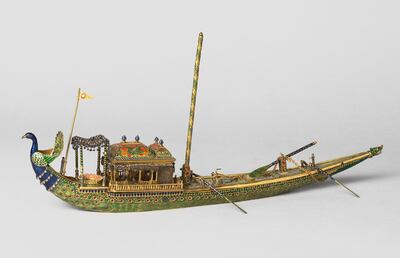
The first eye-catching object in the exhibition is one that also adorns the cover of the accompanying publication by curator Kajal Meghani. It is an enamelled gold peacock inkstand in the form of a state barge known as the Maurpankhi which was presented by the Maharaja of Benares (today Varanasi). It comprises 19 pieces including a penknife, two pen nibs and a pair scissors. Two intricate details mark it as a gift and reveal the identity of the presenter and the receiver: a small gold flag is emblazoned with the Benares crest of two fishes, and the mast is inscribed with a dedication to the prince.
Meghani regards the inkstand as “an incredible example of craftsmanship because of all the colours that the craftsman has used to depict the barge. Enamelling of this type was particularly admired in Europe.”
Her book records the gushing admiration of the Anglo-Indian writer George Birdwood, who became an authority on Indian decorative arts. “Even Paris cannot paint gold with the ruby and coral reds, emerald green, and turquoise and sapphire blues of the enamels of Jaipur, Lahore, Benares, and Lucknow,” he wrote.
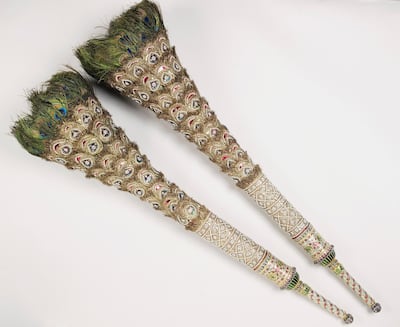
Peacocks appear again, or at least their feathers do, in a pair of large morchals, or fly-whisks, which doubled as fans. They are set with layered bands of gold tinsel and inlaid with diamonds. "Fans like these were used by attendants to fan the ruler and try and keep him cool," says Meghani, "but more so to draw attention to him. He was the most important person in the room."
The prince received other objects pertaining to the traditions of a durbar (court or audience). On view is a lavish 10-piece gold service given by the Maharaja of Mysore. Commonly referred to as a Service of State, the stunning set consists of plates, trays, perfume holders, betel-nut boxes and rosewater sprinklers.
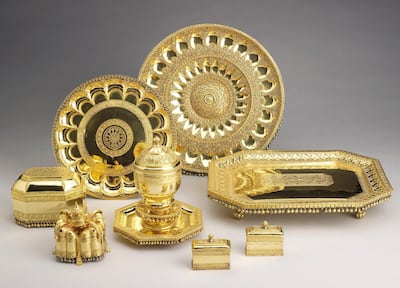
Perfume was used at the beginning of meetings to freshen up after long journeys; paan, or betel-nut, was brought out later to politely signify the end of the session.
When the prince arrived in towns and palaces he was presented with caskets enclosing formal welcoming addresses.
One casket stands out here, and not just because it is silver-gilt rather than standard gold.
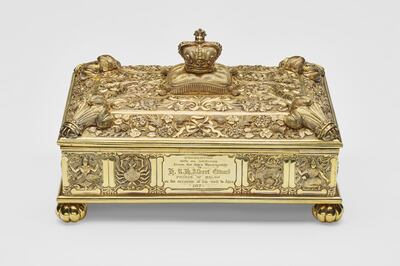
This incongruous gift from Agra, engraved with the prince’s name, was made by an Edinburgh goldsmith. As such, its decorations are something of a cultural mash-up: Hindu and zodiac symbols embellish its sides while its lid is chased with motifs of shamrocks, roses and thistles.
The jewellery section is a trove of glittering treasures.
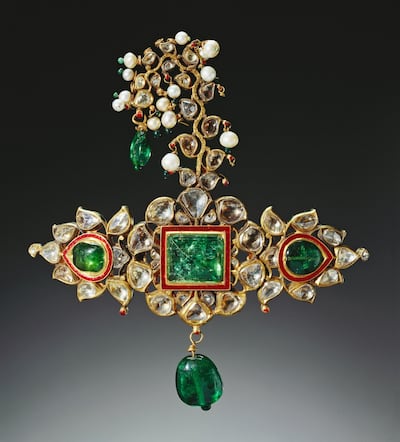
A turban ornament from Udaipur – one of the first gifts the prince received – has as its focal point three large emeralds bordered by bands of bright red enamel. A crown from Lucknow (main picture) is composed of magnificently embroidered velvet and liberally sprinkled diamonds and pearls.
A sculptural gold bangle deserves mention. "It is one of the few items in the exhibition which wasn't a gift to the prince," Meghani says, "but actually an object he bargained for when he was travelling around India." On his tour, the prince bought several such wares from boxwallah, or peddlers, as souvenirs or presents for his family. He purchased this repousse bangle depicting heads of makara (mythical Hindu sea creatures) in Trichinopoly, Madras, and the following year presented it to his mother for her 57th birthday.
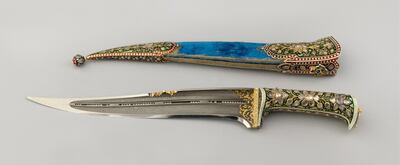
Weapons formed far and away the largest group of presents received by the prince. The exhibition provides an assortment of highly decorative yet fully functioning arms and armoury: a shield crafted from rhinoceros hide and decorated with bosses shaped by curled-up cheetahs; a sword forged from watered crucible steel; a remarkable ornamented dagger whose long blade is filled with loose, moving pearls, and a walking stick gun. An unwieldy and unshowy silver spearhead appears to be the sole dud on display. But closer inspection shows the care with which it has been cut, pierced and chiselled, and the fine detail of its birds and monsters.
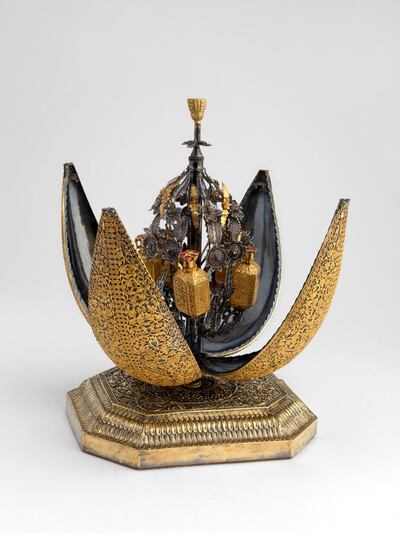
In contrast, an attar-dan from Jaipur bowls over the beholder. One of the gems of the exhibition, this exquisite perfume holder resembles a lotus flower and sits on a plate enamelled with foliate patterns and hunting scenes. It reportedly underwent five firings and took five years to complete.
All objects here are expertly wrought, and all reflect the opulent spendour of the Indian court. However, in some cases there are no small doses or half measures, and instead of being beguiled by artistry and precision we are dazzled by a surfeit of gold or jewel encrustations.
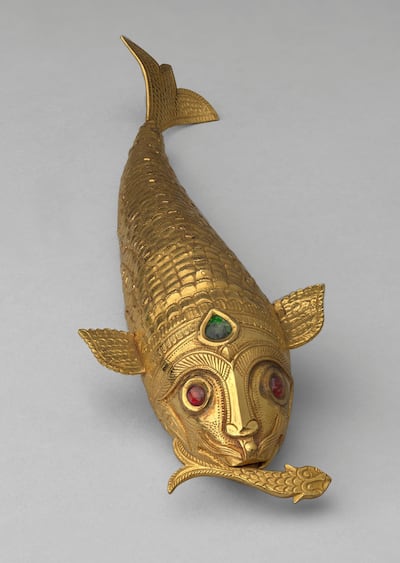
Still, it is hard not to be magicked by the collection as a whole. It isn't the first time the gifts have enchanted. Recognising their cultural value, the prince arranged for them to go on display shortly after returning home in May 1876. In its opening week, 30,000 visitors flocked to the exhibition. It proved so successful that the gifts travelled across the UK, and to Paris and Copenhagen. Their popularity also encouraged many British firms to start manufacturing objects inspired by Indian design.
This is a fascinating exhibition, a cabinet of curios and wonders. The exhibits may have been a series of gifts fit for a future king, but for us lesser mortals they constitute an intriguing array of South Asian works of art.
Splendours of the Subcontinent: A Prince's Tour of India 1875-6 is exhibited at The Queen's Gallery, Palace of Holyroodhouse, Edinburgh, until April 22. For more information, visit www.royalcollection.org.uk
_________________
Read more:
[ This season at Louvre Abu Dhabi: What's on from February until May ]
[ A royal affair: the refurbishment of Suján Rajmahal Palace ]
[ Largest diamond yet auctioned sells for record $34m in Geneva ]
_________________
